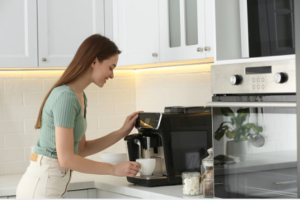Different Types of Coffee Machines
Plenty of coffee machines exist if you own a small business or want to upgrade your home. Each has advantages and drawbacks, so research before making a final decision.
 Businesses can benefit from Adelaide coffee machines an excellent tool to help employees unwind and take a break from work. A full cup of joe may boost productivity or provide much-needed motivation.
Businesses can benefit from Adelaide coffee machines an excellent tool to help employees unwind and take a break from work. A full cup of joe may boost productivity or provide much-needed motivation.
Drip coffee makers
Drip coffee makers are an easy and convenient way to make delicious coffee. Not only are they user-friendly, but they don’t need any exceptional brewing experience either. As an affordable and handy product, they have become popular among coffee connoisseurs and those needing a quick pick-me-up.
Drip coffee machines brew coffee by spraying hot water over ground coffee, which allows the grounds to absorb the flavours of the water and release their aroma. A drip coffee maker consists of several components, such as a water reservoir, power switch, heating element, showerhead, filter compartment and carafe.
The water in the reservoir is heated by an element, causing it to boil. Then, after passing through a tube that collects it, hot water escapes through and into the showerhead.
This process allows the coffee grounds to steep in hot water for longer, creating an enhanced flavour. Furthermore, it helps protect them from being burned by excessive heat.
Many drip coffee makers come equipped with a timer, so you can program the machine to brew a cup when desired. This feature is handy if you get up early and want your coffee ready before heading out the door.
When selecting a coffee machine, look for one with programmable brewing times and an auto-cleaning cycle. These will help keep your device running optimally and ensure you never miss a brew.
A quality drip coffee maker also features temperature control to select the ideal water temperature for brewing. Furthermore, look for a model with a thermal carafe; this will keep your beverage warm without burning for hours.
Another essential feature of a quality Adelaide coffee machines is an unclogged one-way valve, which keeps hot water from escaping. Unfortunately, this issue often arises with drip coffee makers, so cleaning the valve regularly is essential.
Some drip coffee makers even allow you to ice your coffee, providing an enjoyable way to cool off in the summertime. Be sure to weigh the water before pouring it into your pot, as the markings on the container or carafe may not be accurate.
Espresso machines
Espresso machines are designed to brew the perfect cup of coffee in just a few seconds. They produce a more substantial, creamier and more aromatic cup than drip coffee makers can provide.
These machines brew coffee by applying high pressure to ground beans at high force rates. They come in various designs, such as steam-driven, piston-driven or pump-driven options.
Luigi Bezzera, of Milanese industrial fame, invented the first espresso machine in the early 20th century. He modified Angelo Moriondo’s steam-powered device and made several improvements, such as using a portafilter to fill it with ground coffee.
Bezzera’s invention marked the start of modern espresso production, but it would take years for this technique to be perfected. Ultimately, Milanese manufacturer Desiderio Pavoni took Bezzera’s design and created what we now know as the espresso machine we know today.
Gaggia’s lever-driven machine revolutionised espresso-brewing by creating an atmosphere that could produce shots with more than two bars of pressure, unlike the Bezzera system’s steam-driven mechanism that needed to push water through grounds. Not only did this standardise shot sizes, but it also introduced crema – that foam that floats atop each shot for an authentic espresso shot.
The second major revolution in espresso machine design occurred with the invention of pump-driven machines in 1961. These units used pumps instead of spring piston levers to generate nine atmospheric pressure bars to pull a quality espresso shot.
These machines can be found in the home or commercial settings and require a separate boiler for each type of brewing (hot water and steam). There are four variants: HX for hot water only, hot water with steam, steam only, and dual-boiler setups.
Heat Exchanger Boilers are usually found in higher-end machines and allow users to temperature surf, which enables them to alter the boiler’s water temperature for optimal brewing results. Unfortunately, this method isn’t as stable as using a single boiler.
